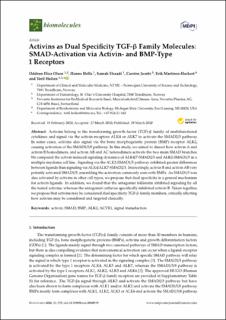| dc.contributor.author | Olsen, Oddrun Elise | |
| dc.contributor.author | Hella, Hanne | |
| dc.contributor.author | Elsaadi, Samah | |
| dc.contributor.author | Jacobi, Carsten | |
| dc.contributor.author | Martinez-Hackert, Erik | |
| dc.contributor.author | Holien, Toril | |
| dc.date.accessioned | 2020-04-14T07:48:13Z | |
| dc.date.available | 2020-04-14T07:48:13Z | |
| dc.date.created | 2020-04-09T12:04:03Z | |
| dc.date.issued | 2020 | |
| dc.identifier.issn | 2218-273X | |
| dc.identifier.uri | https://hdl.handle.net/11250/2650883 | |
| dc.description.abstract | Activins belong to the transforming growth factor (TGF)-β family of multifunctional cytokines and signal via the activin receptors ALK4 or ALK7 to activate the SMAD2/3 pathway. In some cases, activins also signal via the bone morphogenetic protein (BMP) receptor ALK2, causing activation of the SMAD1/5/8 pathway. In this study, we aimed to dissect how activin A and activin B homodimers, and activin AB and AC heterodimers activate the two main SMAD branches. We compared the activin-induced signaling dynamics of ALK4/7-SMAD2/3 and ALK2-SMAD1/5 in a multiple myeloma cell line. Signaling via the ALK2-SMAD1/5 pathway exhibited greater differences between ligands than signaling via ALK4/ALK7-SMAD2/3. Interestingly, activin B and activin AB very potently activated SMAD1/5, resembling the activation commonly seen with BMPs. As SMAD1/5 was also activated by activins in other cell types, we propose that dual specificity is a general mechanism for activin ligands. In addition, we found that the antagonist follistatin inhibited signaling by all the tested activins, whereas the antagonist cerberus specifically inhibited activin B. Taken together, we propose that activins may be considered dual specificity TGF-β family members, critically affecting how activins may be considered and targeted clinically. | en_US |
| dc.language.iso | eng | en_US |
| dc.publisher | MDPI | en_US |
| dc.relation.uri | https://www.mdpi.com/2218-273X/10/4/519 | |
| dc.rights | Navngivelse 4.0 Internasjonal | * |
| dc.rights.uri | http://creativecommons.org/licenses/by/4.0/deed.no | * |
| dc.title | Activins as Dual Specificity TGF-β Family Molecules: SMAD-Activation via Activin- and BMP-Type 1 Receptors | en_US |
| dc.type | Peer reviewed | en_US |
| dc.type | Journal article | en_US |
| dc.description.version | publishedVersion | en_US |
| dc.source.volume | 10 | en_US |
| dc.source.journal | Biomolecules | en_US |
| dc.source.issue | 4 | en_US |
| dc.identifier.doi | 10.3390/biom10040519 | |
| dc.identifier.cristin | 1805735 | |
| dc.description.localcode | © 2020 by the authors. Licensee MDPI, Basel, Switzerland. This article is an open access article distributed under the terms and conditions of the Creative Commons Attribution (CC BY) license (http://creativecommons.org/licenses/by/4.0/). | en_US |
| cristin.ispublished | true | |
| cristin.fulltext | original | |
| cristin.qualitycode | 1 | |

